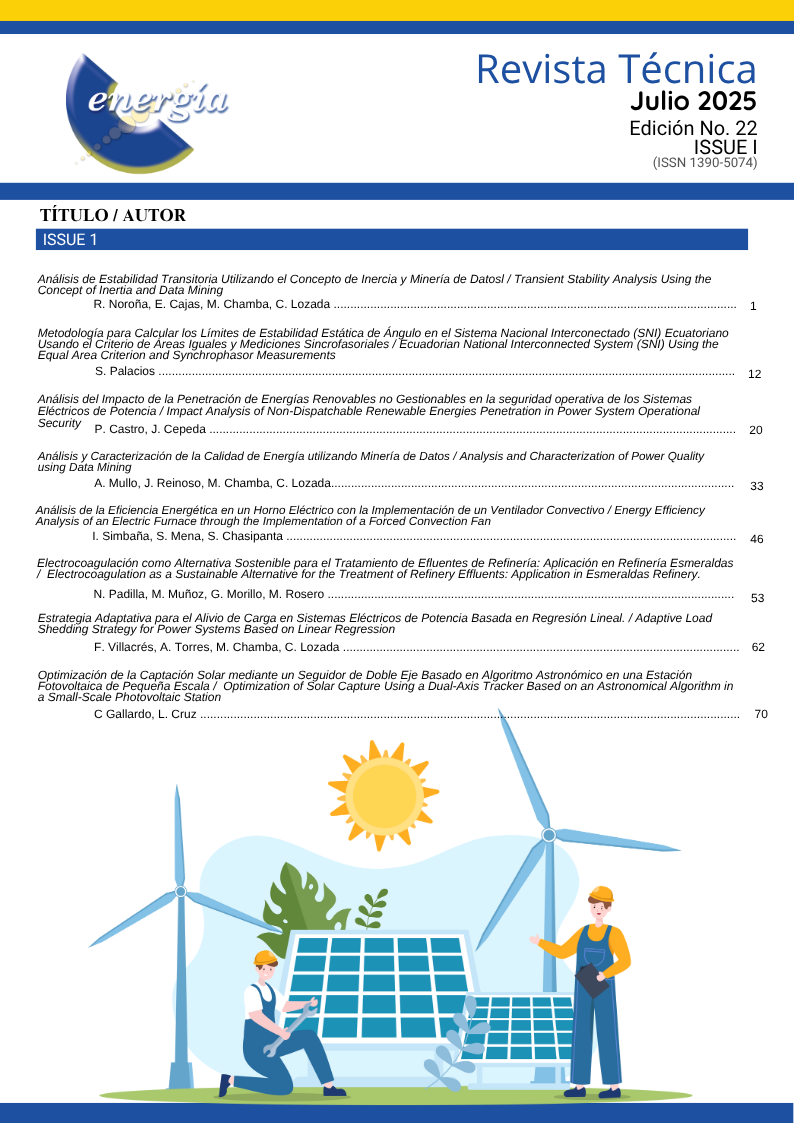Optimization of Solar Capture Using a Dual-Axis Tracker Based on an Astronomical Algorithm in a Small-Scale Photovoltaic Station
Main Article Content
Abstract
This paper presents the design, implementation, and evaluation of a dual-axis solar tracking system based on an intermediate-resolution astronomical algorithm. The system was installed on the rooftop of Block B at the Technical University of Cotopaxi and consists exclusively of photovoltaic modules, with no inverters or loads, allowing safe measurement of short-circuit current (Isc) as an indicator of energy capture. Two calibrated photovoltaic reference cells were used to record the incident irradiance on both a mobile and a fixed array (inclined at 15° north). The astronomical algorithm calculates solar elevation and azimuth angles in real time, triggering actuator movement when angular deviation exceeds ±1°. Results show a 19.85% average increase in irradiance captured by the mobile system compared to the fixed system. Additionally, the correlation between inclination angle and irradiance is analyzed, and the solar path model is validated. This research constitutes the first phase of a broader project that will integrate hybrid control strategies and economic analysis in future stages.
Downloads
Article Details

This work is licensed under a Creative Commons Attribution-NonCommercial 4.0 International License.
Aviso de Derechos de Autor
La Revista Técnica "energía" está bajo licencia internacional Creative Commons Reconocimiento-NoComercial 4.0.
References
REN21, "Renewables 2022 Global Status Report," REN21 Secretariat, Paris, 2022.
IRENA, "Renewable Power Generation Costs in 2022," International Renewable Energy Agency, Abu Dhabi, 2023.
C.R. Batista Rodríguez, R.I. Urquiza Salgado, "Cálculo y análisis de la máxima eficiencia anual de los seguidores solares," Entre Ciencia e Ingeniería, 2019.
N.A. Kelly, T.L. Gibson, "Improved photovoltaic energy output for cloudy conditions with a solar tracking system," Solar Energy, vol. 83, pp. 2092-2102, 2009.
Atlas Solar del Ecuador, Ministerio de Energía y Recursos Naturales No Renovables, 2021.
A. Sabri Allw, I. Hameem Shallal, "Evaluation of photovoltaic solar power of a dual-axis tracking system," Journal of Southwest Jiaotong University, 2020.
J.M. Enrique et al., "A reliable, fast and low-cost maximum power point tracker for photovoltaic applications," Renewable Energy, 2009.
A. Escobar Mejía et al., "Diseño e implementación de un seguidor solar para la optimización de un sistema fotovoltaico," Scientia et Technica, 2010.
Estudio de Seguimiento Solar en Ecuador, Universidad Técnica Particular de Loja, 2020.
Vaca Padilla, G. P., & Vega Toaquiza, J. S. (2021). Implementación de un seguidor solar de 2 ejes para un sistema fotovoltaico de 560 W [Tesis de grado, Universidad Técnica de Cotopaxi]. Repositorio UTC. https://repositorio.utc.edu.ec/items/fd71b602-cbd9-4d7a-8622-ab5d08700d1a
Chisaguano Chicaiza, C. R., & Hurtado Buni, C. F. (2022). Implementación de un sistema de control de posición angular para una estación fotovoltaica de 560 W de 2 ejes [Tesis de grado, Universidad Técnica de Cotopaxi]. Repositorio UTC. https://repositorio.utc.edu.ec/items/bd550748-55d5-480a-804f-c708cbdaa081
N. Machado Toranzo, A. Lussó Cervantes, L. L. Oro Carralero, J. Bonzon Henríquez y O. Escalona Costa, «Seguidor Solar, optimizando el aprovechamiento de la energía solar,» SCIELO, vol. 36, nº 2, 2015.
D. E. M.J. Clifford, «Diseño de un novedoso seguidor solar pasivo,» ELSEVIER, vol. 77, nº 3, pp. 269-280, 2004.
C. R. Batista Rodriguez y R. I. Urquiza Salgado, «Cálculo y análisis de la máxima eficiencia anual de los seguidores solares,» Entre Ciencia E Ingeniería, vol. 12, nº 24, pp. 25 - 31, 23 05 2019.
T. Partridge, «Inter Press Service,» 03 02 2021. [En línea]. Available: https://ipsnoticias.net/2021/02/proyecto-solar-aromo-reto-las-renovables-ecuador/. [Último acceso: 04 12 2021].
A. Escobar Mejia, M. Holguín Londeño y J. C. Osorio R., «Diseño e implementación de un seguidor solar para la optimización de un sistema fotovoltaico,» Scientia et Technica, nº 44, p. 6, 2010.
J. M. Enrique, J. M. Andújar y M. A. Bohórquez, «A reliable, fast and low cost maximum power point tracker for photovoltaic applications,» ELSEVIER, p. 11, 2009.
J. Reda and A. Andreas, Solar Position Algorithm for Solar Radiation Applications, NREL Report No. TP-560-34302, Revised January 2008, National Renewable Energy Laboratory, Golden, Colorado, USA.



